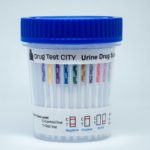
One of the questions we are most often asked is if drug tests test for alcohol. The short answer is that no, drug tests usually do not test for alcohol.
There are exceptions to this rule and many drug tests will include a separate alcohol urine test, but an alcohol test strip is not normally found on 12 panel tests themselves.
The most common drugs included on a 12 panel test are cocaine, marijuana, opiates, oxycodone, benzodiazepines, methamphetamine, amphetamine, methadone, suboxone, barbiturates, ecstasy, tricyclic antidepressants and PCP.
Do Drug Tests Test for Alcohol
You can get a drug test configured with any combination of testing strips you want. However unless you are running a sophisticated laboratory that is capable of high complexity testing most professionals need a test that is CLIA waived to meet state and federal regulations.
There are 14 Panel drug tests drugs that include a test for alcohol, but . Alcohol is not CLIA waived, so these tests are for forensic use only.

Lots of people use drug testing in a forensic capacity. If you suspect someone of being drunk on the job you can request that the employee take an ETG test. If the test is positive it is probably cause to send the employee for more thorough testing or to send them home. So even though alcohol tests aren’t CLIA waived they can still be useful.
The solution most organizations use is to use 12 panel CLIA waived drug tests for the bulk of their testing and supplement those tests with single dip cards for additional drugs and alcohol. By doing it this way the majority of drugs are covered by a CLIA waived test and the additional tests can be deployed on an as needed basis.
Why You Should Test For Recent Alcohol Use
Since alcohol is legal for consumption in the U.S. alcohol urine tests are most often used for people in drug and alcohol recovery or for people that are prescribed medications that are not supposed to be taken with alcohol. The detection time is roughly 8-24 hours so a urine alcohol test is practically a test for recent alcohol use.
55.3% of people admit to drinking in the past month and 70% admit to drinking in the last year. Alcohol is by far the most commonly abused drug on the job, almost 3 times as common as marijuana which is the second most commonly abused drug at work.

Alcohol tests can also be a useful tool as evidence against employees that may be drinking on the job.
We recently covered a multitude of reasons why employers drug test. It is clear that active drug and alcohol users are less productive and get in more accidents, but it’s also worth noting that their accidents are more costly and dangerous.
According to Bradford Health Services Workplace accidents caused by inebriation or hangover are 5 times as likely to injure someone. 40% of all workplace fatalities are caused by substance abusers.
Addressing Employment Related Alcohol Abuse
Younger male workers, tradespersons, and lower skilled workers are more likely to abuse alcohol both on and off the job. Company culture can play a big part in an individual’s pattern of behavior, especially when it comes to alcohol consumption. Entertaining clients and working in an environment where alcohol is freely available are factors in on the job alcohol consumption. Some industries are at an increased risk for abuse alcohol. These include:
- Hospitality
- Mining
- Agriculture
- Retail
- Manufacturing
- Construction
- Financial services
Some contributing factors to employees that abuse alcohol are:
- Isolation
- Long Hours
- Relationships with employees
- Company culture
- Inadequate supervision
- Employee morale
- Poor working conditions
It is everyone’s responsibility to monitor alcohol use and abuse in and around the workplace, but the Occupational Health and Safety Act of 1994 obligate employers to respond to alcohol use and any related harm in the workplace. Every employer should maintain a drug free workplace policy. It is prudent to randomly include alcohol urine screens in random drug tests and always test for alcohol in a post-accident screening. Besides recent alcohol use testing employers can
- Promote health and fitness in the workplace
- Offer more education and training programs
- Provide access to treatment and counseling services
- Draft a fitness for work policy that addresses alcohol specifically


